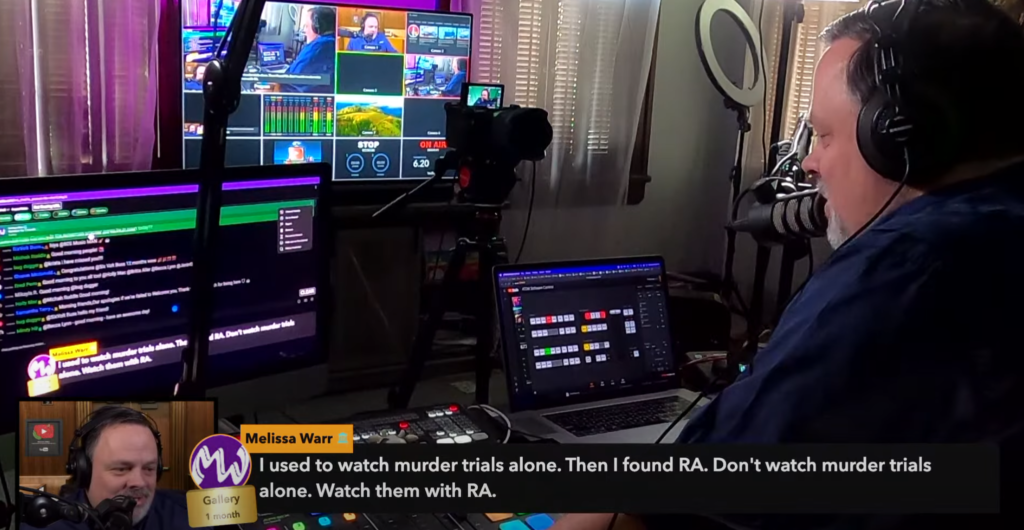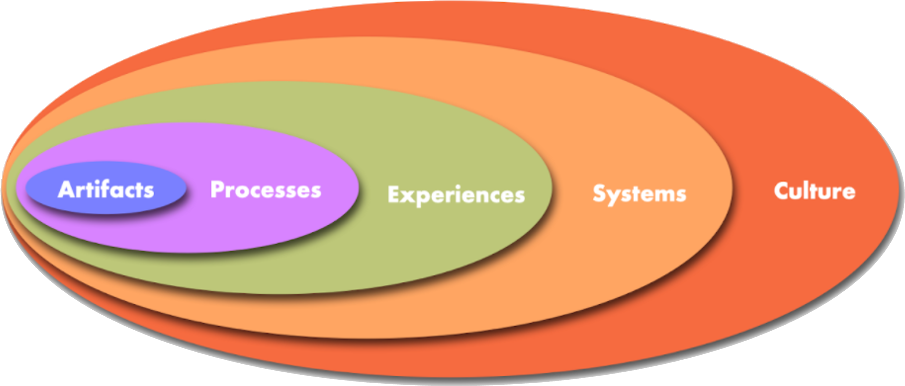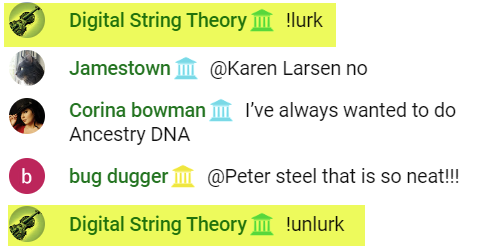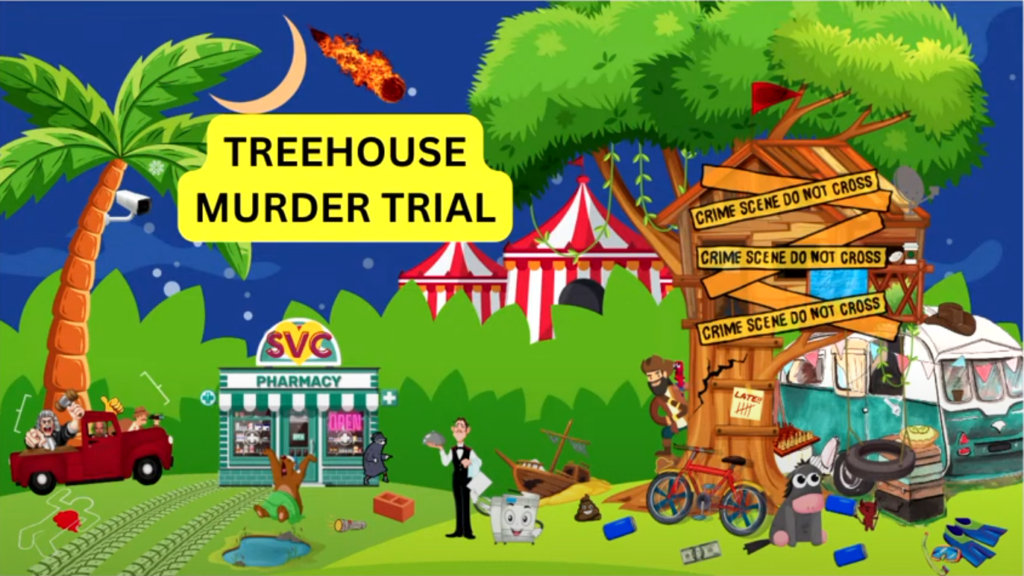A little break from bias in AI this week…about how I take a break from bias and AI…
TLDR: This post got a bit long…I like watching trials on YouTube. There’s a cool community called Recovery Addict that makes it extra fun through intentionally designed culture, systems, experiences, processes, and artifacts–the Five Spaces for Design!
OK. Full post:
A few years ago, I found a new past time. Watching murder trials on YouTube. Weird, but true. There are years worth of trials to watch…it’s like really real reality TV, all the drama, all the weirdness. Suspense and real world consequences.
This is not only a strange past time, but a fun conversation piece. However, it can get a bit dark at times, requiring caution on my end about getting in too deep. Last year I found a new channel that solved that problem, not only allowing my obsession to continue, but to become much more fun. As I shared with Recovery Addict (RA), the creator and host, a few months ago…

Why should you watch murder trials with Recover Addict, you ask? Because he has intentionally designed a unique type of trial watching experience, building a channel culture that reinforces this experience through use of artifacts and processes. Yes, RA has become my new favorite example of the Five Spaces for Design in Education (or more specifically, legal education).

RA streams trials about eight hours a day (yes, it is his job). Sometimes they are the big trials everyone is watching…like Alex Murdaugh, Johns Hopkins All Children’s Hospital vs. Maya Kowalski, or the recent parent-of-school-shooter Jennifer Crumbly. Between these heavy cases, he lightens things up, “court-hopping” the daily parole hearings, divorce court, and small town crime with an occasional police chase thrown in.
This has led to several channel favorites–the sharp and charismatic Judge Boyd in Texas or tiny jury trials in Thurston County, Washington. Finding these small pockets of entertainment can require slugging through slower cases, but hundreds to thousands of subscribers keep watching as they wait for these big moments.
OK. That’s the background. Here’s how it fits with the Five Spaces framework.
Recovery Addict is very intentional about the type of culture and experience he wants to create, one that is much more positive and often light-hearted than other places to watch true crime. As a nerdy academic, I can’t help but analyze how this happens. Let’s break it down by the spaces. We’ll go backwards, starting with the culture and working back to the artifacts that support that culture.
Culture: RA has developed an inclusive and respectful culture, one that honors the legal system, encourages open-mindedness, and supports both entertainment and learning.
Culture is most visible through descriptions of experience. Recovery Addict finds that sweet balance between drama, analysis, legalese, and humor. Watching it often feels like joining a bunch of family and friends Mystery Science Theater 3000 style. Through YouTube Chat, viewers make witty comments, building on each other’s jokes, reinforcing historical themes from past trials.
At other times, it’s more like a therapy session, sharing personal experiences about difficult topics such as illness, school shootings, trauma, or domestic violence. Although this can be heavy, it is also cathartic and has broadened my awareness and empathy of others’ experiences. It encourages respect and empathy.
Members have picked up on RA’s language and tone to make it feel like they are in a class or at work, where their job is to watch these trials–including a special Saturday stream full of jokes about being paid overtime.

Systems: Part of the system that supports this channel is YouTube’s set-up with live chat, membership/anniversary systems, and back-end tools for content creators and streamers. That part is a bit boring (and honestly, I don’t know much about it).
RA has built on these systems to create his own channel structure. Like many channels, RA has moderators (mods) work in the background to monitor the live chat. On Recovery addict, they focus on deleting inappropriate comments and encouraging a welcoming feeling. They keep chat on topic and reinforce the desired tone. There is even a special emoji that honors their hard work.
RA himself selects specific chat comments to highlight on the stream, further reinforcing the tone of the community. This allows for a similar experience whether you are watching on your computer and participating in the live chat, “lurking” with RA on the TV, or joining the “re-watch crew” after the live stream. In other words, you can participate without fully participating–you feel the community through the highlighted chats even when not chatting. In fact, RA recognizes this and validates different types of watching using chat commands…to be explained later…
Experiences form the middle space for design, influenced by culture and created through artifacts. I’ve already talked a bit about the experience of watching RA, and experience is at the heart of why I keep watching. One piece I haven’t mentioned is the “burner phone,” a number watchers can call during breaks for live participation or can text links to RA; another way to experience the channel. The channel experience is reinforced by processes and artifacts.
Processes are like templates, they are what happens consistently but in slightly different ways each time. Processes include:
- Opening stream theme song that includes images and sound clips from significant moments in the channel’s history.
- First in chat is in charge of the internet for the day
- Morning birthday song, where chatters can share that it is their birthday and RA leads a worldwide happy birthday song for those members (in the early days of the channel, RA would do a “role call” of everyone in chat; it has gotten too large for that so the birthday song is a fantastic way to call out individuals at a smaller scale)
- Wednesday Hump Day yell
- Verdict watch and announcements–artifacts like an on-screen timer and verdict music make it exciting every time, even with the small cases. It feels like you are at a sporting event!
Artifacts–images, sounds, interactive functions-–build these processes and experiences. Just a sample here:

- Camera set-up: RA sets up his screen so that users can see his face but also the technical side. I have found myself looking at the chat stream on his computer, looking for my profile pic, and it feels like I’m right there with him!
- Counters: during many trials, a counter appears at the bottom right corner of the screen. This counter may be documenting objections, apologies, “law 101” statements by the judge, squeaky sounds, and the list goes on. Chat members remind RA to add to the counter when he misses it, and it makes a fun inside joke. It was even reference by an attorney in a trial.
- Chat user commands: RA has built commands into the live chat the allow watchers to produce special commands such as !late, !seat, !lurk, !unlurk (which I was delighted to discover a few weeks ago…). Other commands actually activate classic sound clips from previous trials (RA can turn the volume up and down on these depending on the situation.
- Video thumbnails: these change for trials, sometimes they are even community-created
- Opening/closing music


Ultimately, all these overlapping elements come together to make it a successful channel…evidenced by the large number of paying members (it is the only channel I donate to, even though you don’t need to pay to have the full experience), rapid growth, shout-outs by other YouTube channels, and sometimes even in-the-wild mentions in court proceedings and filings!

Intentional Design?
RA often comments that the community is what makes the channel, and I agree. Frequent chat and phone participants bring their own personalities, support each other, and are, frankly, quite hilarious. However, it is these intentional design elements that have created the environment that has produced this chat. It’s sort of like the fertile environment of a petri dish, providing the nourishment and environment that allows it to flourish (I know, very unscientific and not exactly correct, but it’s the best metaphor I can think of).
Some things have also just been random–hearing the stream played during live court, attorney complaint about an apology counter during closing arguments, “secret agents” that call the burner phone that make their way into defense motion filings, bringing the community into the real trial–but it is RA that nourishes the culture.
Of course, the personality and comedic charm of Recovery Addict himself perfectly fits into this design, and without that the whole thing would probably fall apart (examples: Yoga time with Black Widower, Judge Carroll’s baldness analogy). But it is the unique alignment of these elements–artifacts that build processes that form an experience, systems and culture reinforcing that experience, that has allowed this community to flourish. And, if you haven’t noticed yet, I love it!